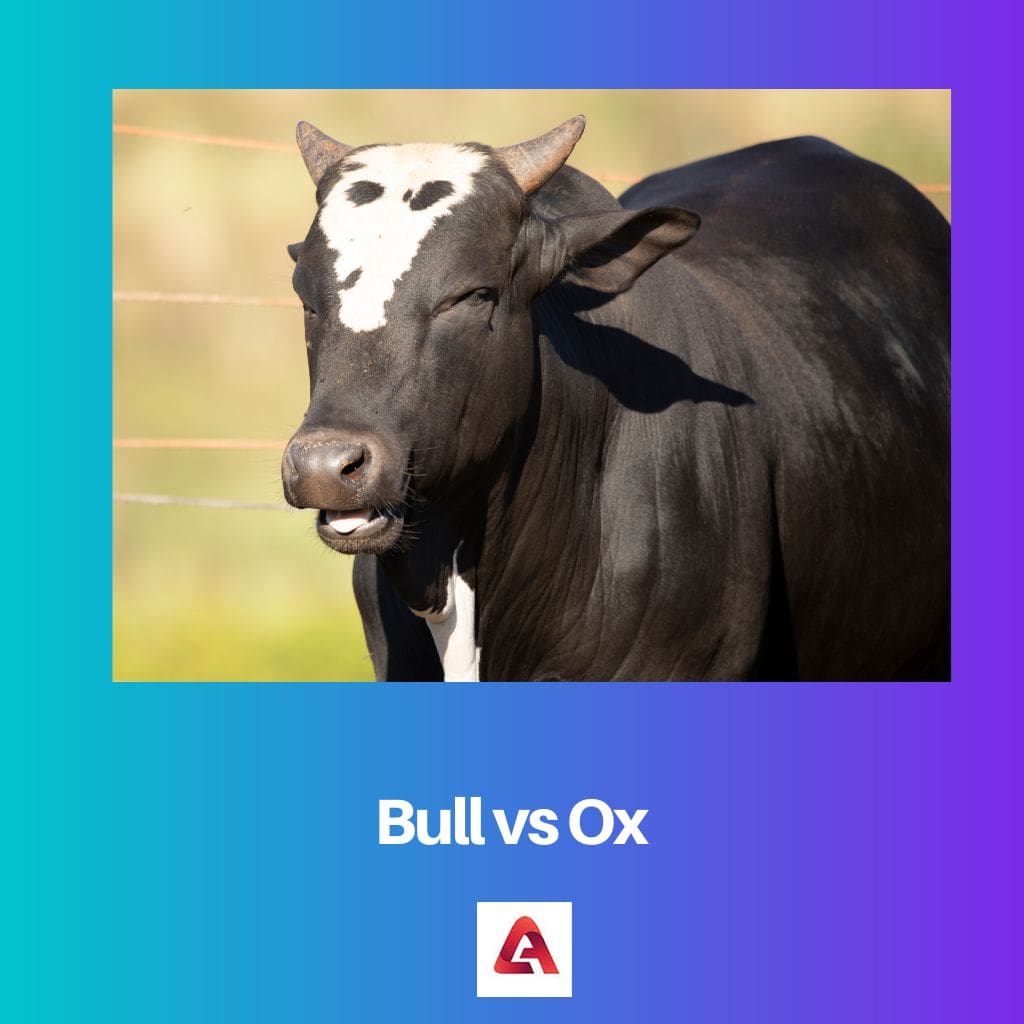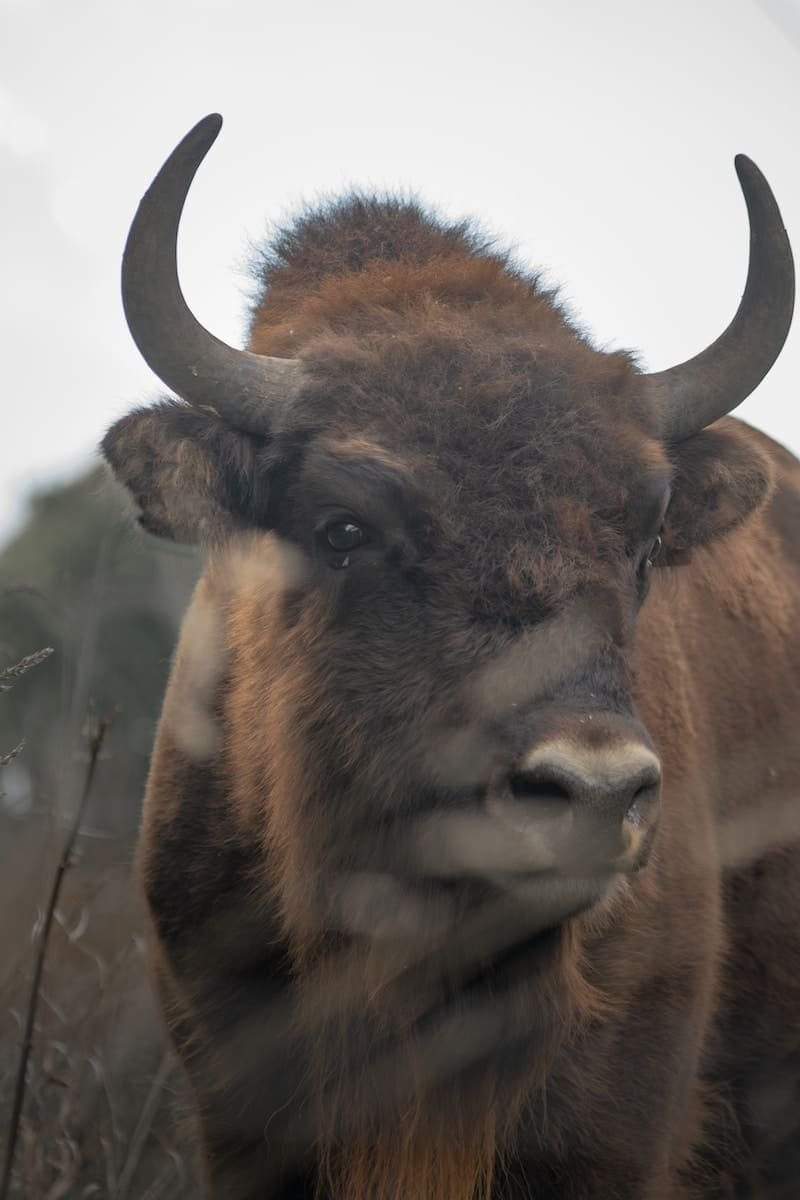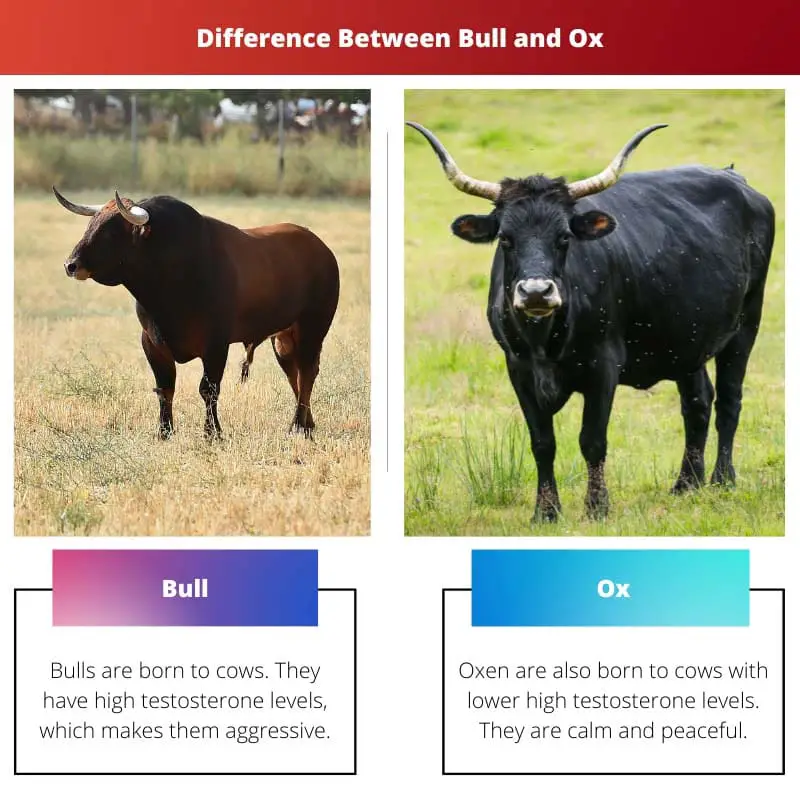Cows are used to give dairy. Ox and bull are both adult male cattle. They both are males of the same species but have different roles.
Bulls and oxen are both born to cows and belong to the same species. They are both male species with differences between them. Bulls and oxen belong to male herbivores species.
Key Takeaways
- Bulls are male cattle used for breeding and have intact reproductive organs, whereas oxen are castrated male cattle used for work.
- Oxen are more docile and better suited for tasks like plowing and pulling carts, while bulls are known for their aggressive behavior.
- Bulls have larger and more muscular bodies than oxen due to their role in breeding.
Bull vs Ox
An ox is a sub-genus of the cattle used for pulling things. It is larger than a bull. It is commonly a castrated adult male cattle which inhibits testosterone and aggression and makes the males docile and safer to work. A bull refers to cattle (or cows) of the male gender.

Bulls are born to cows. They have high testosterone levels, which makes them aggressive. They are used for breeding. Bulls have a smaller body size. Bulls weigh up to six hundred pounds.
Bulls have horns and can produce milk. Bulls are slaughtered for beef because they are only useful for breeding. The tail of bulls can grow up to 4 feet.
Oxen are also born to cows with lower high testosterone levels. They are calm and peaceful. They are used to plow fields, pull loads, transport goods, and do labor-intensive work.
Oxen have a larger body size. They weigh up to a thousand pounds, oxen do not have horns and cannot produce milk.
Comparison Table
| Parameters of Comparison | Bull | Ox |
|---|---|---|
| Species | Bulls are fertile male adult cattle, members of the bovine family. | Ox is a cattle which refers to a castrated bull of the Taurus species. |
| Purpose | Bulls are used for breeding purposes. | Ox are animals used for transportation purposes and labor-intensive work. |
| Behavior | Bulls are violent in nature. | Oxen are calm and peaceful. |
| Body size | bulls have a smaller body size. | Oxen have a larger body size. |
| Usefulness | Bulls are slaughtered for beef because they are only useful for breeding. | Oxen, on the other hand, are not slaughtered for beef as they are much more useful than bulls. |
| Weight | Bulls weigh up to six hundred pounds. | Oxen weigh up to a thousand pounds. |
| Horns | Bulls have horns. | Oxen do not have horns. |
| Span | Bulls live for around twenty years. | Oxen lives for ten years. |
| Milk | Bulls can produce milk. | Oxen cannot produce milk. |
What is Bull?
Bulls are the male adults’ cattle. They are used for breeding purposes. They seem more muscular than ox due to the male testosterone levels.
Bulls are from the Bos taurus species. They are muscular and are used to mate with the females to increase the population of the cattle.
Bulls have high hormones, which can make them difficult to control. They are not used for riding or plowing and are kept isolated.
Apart from breeding, they cannot serve any other purpose, which is why they are slaughtered for beef before they reach puberty.
Bulls are important to increase the population of cattle which can also increase the production of beef and dairy.
Bulls are strong and aggressive in nature thus are not sterilized. Bulls are a symbol of power and strength.
Bulls require more food than ox to maintain their body weight. Bulls weigh up to 600 pounds. Bulls have horns. The tail of bulls can grow up to 4 feet. Bulls are the males who can produce milk. Bulls can live up to 20 years.
They can eat hay, corn, apples. Bull calves are also used in bullfighting and riding. Bulls are characterized because of their reproductive parts. Bulls are more muscular than oxen.

What is Ox?
Ox is male cattle which refers to a castrated bull of the Taurus species. They are fully grown. The adult does not have the ability to breed with the females.
Ox is used to do the lifting. They are larger in size. Oxen are less aggressive. They are used to plow fields, pull loads, transport goods, and do labor-intensive work.
Oxen are castrated while being young. Oxen are calmer in nature than bulls. They are not slaughtered for beef as they are useful.
Oxen are heavier and bigger in size than bulls. They can weigh up to a thousand pounds. They are resilient animals and are docile in nature. Oxen can live up to 10 years.
They do not have horns and cannot produce milk.

Main Differences Between Bull and Ox
- Bulls can produce milk, whereas oxen cannot produce milk.
- Bulls and oxen are both herbivores.
- Bulls are comparatively smaller in size than oxen.
- Bulls can live up to 20 years, whereas oxen can live up to 10 years.
- Bulls have higher levels of testosterone than oxen.
- Bulls are more aggressive, whereas oxen are calm.
- Bulls are used for breeding with the females, whereas oxen are used to plow the fields or are used to carry heavyweights.
- Bulls are kept isolated because of their nature, whereas oxen are kept in herds.
- Bulls are slaughtered for beef more than oxen.
- Oxen are castrated, whereas bulls are not castrated.
- The breeding of bulls is not controlled, whereas the breeding of an ox is controlled.




